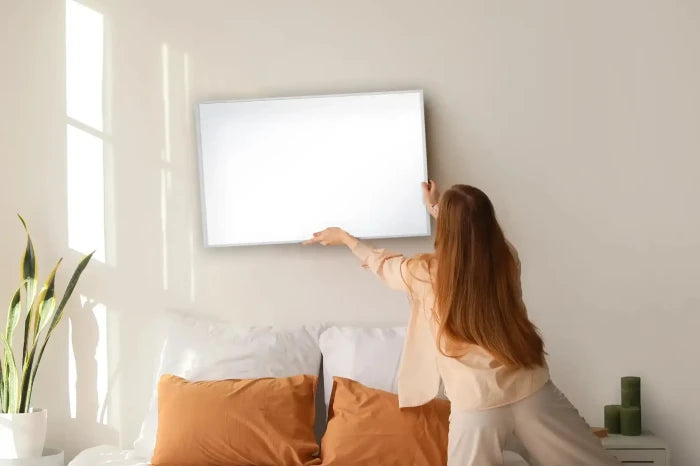In this day and age, there are multiple ways to heat your home, but finding the right heating system can be more than just a little bit difficult, since whatever you choose needs to be suited to your needs, and you also need to consider what will be best for your wallet. As we are still going through the winter season, deciding when to keep your heating on and how long for can become very expensive, especially with the rising energy costs. This blog will look to explore the most common types of heating across the UK.
A census taken in 2021 found that 73.8% of homes used mains gas, 9.1% used central heating, 8.5% used electric heating, 3.5% used oil and 2.5% used other forms of central heating such as solid fuel or renewable. Since it is 2024, no doubt that the numbers would have changed ever so slightly, especially since new homes now being built come without gas and run only on electricity.  1. Gas-Based Central Heating
1. Gas-Based Central Heating
Gas central heating remains the most common heating system in UK homes, working by circulating hot water or air through a network of radiators or underfloor pipes to warm multiple rooms. It’s effective — but far from perfect.
Installation & Running Costs
Installing a gas system can be expensive and disruptive, particularly for homes not connected to the national gas grid. And with gas prices tied to volatile global markets, running costs can spike without warning — a major concern in the current energy climate.
High Maintenance = Higher Costs
Gas boilers require regular servicing to run safely and efficiently. When things go wrong — and they do — the entire system can shut down, including your hot water. Emergency call-outs for a broken boiler can range from £90 to £200+, with full replacements costing even more.
Environmental Impact
While often promoted as a “cleaner” fossil fuel, natural gas still releases significant carbon emissions. Burning gas contributes to air pollution and climate change — making it less appealing as we push toward net-zero goals.
Gas heating also carries the risk of carbon monoxide leaks, so detectors are essential to keep your home safe.

2. Electric Central Heating
Electric central heating is becoming increasingly common in UK homes — especially new builds that are not connected to the gas network. Originally developed in Germany during the 1920s and gaining popularity in the UK post-1950s (particularly in social housing), electric heating was seen as a cost-effective solution. These early systems used night storage heaters, which charged overnight and released heat gradually throughout the day.
Today, modern electric heating has evolved significantly. Thanks to LOT20 legislation, electric heaters must now come equipped with programmable timers, thermostats, and energy-saving controls. However, high-quality electric heaters with advanced features can still come at a premium price.
Common Issues with Electric Heating:
- High running costs: With the UK average at 29p per kWh, a 2kW storage heater could cost around 58p per hour — and you’ll likely need to run it for several hours to maintain a comfortable temperature.
- Slower heat-up time: Unlike other systems, electric convection heaters can be sluggish to respond, often leaving cold spots in larger or poorly insulated areas.
- Not ideal for poorly insulated homes: The inefficiency of trying to warm draughty rooms can lead to increased energy consumption — and higher bills.
While electric heating is low-maintenance and doesn’t rely on fossil fuels, its performance heavily depends on insulation, room size, and heater quality. If your home isn't properly insulated, it could end up costing you more in the long run.

3. Oil-Based Central Heating
Oil central heating systems are still used in around 1.1 million UK homes, particularly in rural or off-grid areas. These systems work by burning oil to heat water, which is then circulated through radiators or underfloor pipes to warm the home. The oil itself is stored in an outdoor tank and delivered by a supplier.
Installation & Running Costs
While oil heating can be effective, the need for an external storage tank adds a significant upfront cost. Although you can bulk-buy oil, prices are unpredictable and heavily influenced by global supply chains and political events — especially in winter, when demand spikes.
Environmental Considerations
Oil is a fossil fuel with a larger environmental footprint than gas. Though low-sulphur and biofuel alternatives are now available and more eco-friendly, they often come at a higher price point.
In line with the UK’s 2018 Clean Growth Strategy, oil-based heating systems are being actively discouraged. From 2025, the government plans to phase out new installations of oil and gas heating in homes, urging homeowners to switch to low-carbon alternatives.

4. Infrared Heating
If you're looking for a more sustainable and efficient way to heat your home, Far Infrared (FIR) radiant heating could be the perfect solution. While infrared technology has been around for years, it’s still a relatively new concept in UK homes, especially within the domestic market.
How It Works
Infrared heating panels and bars deliver targeted warmth by heating people, pets, and surfaces directly — rather than the surrounding air. This method reduces heat loss and makes the system significantly more efficient, especially in poorly insulated or draughty spaces.
Unlike traditional radiators, which rely on convection (warming the air), infrared waves penetrate the room's structure, warming walls, floors, and furniture — much like how the sun’s rays warm your skin on a cold day. The heat is invisible and free from UV radiation, making it completely safe and incredibly comfortable.
Bonus Benefit: Perfect for Solar Power
One of the standout advantages of infrared heating is how well it pairs with solar panels. Because IR panels use low wattage and operate efficiently, they're ideal for homes generating their own electricity, offering a true low-carbon heating solution.
 What are the health benefits of infrared heating?
What are the health benefits of infrared heating?
1. Prevents Mould and Condensation:
As mentioned previously, IR heating heats up the foundation of your home, and because of this, it helps to prevent mould. Having central gas/oil heating means that the heat produced will rise up, along with the moisture, preventing condensation and dampness.
2. Allergy Friendly and Better Air Quality:
IR radiant heating doesn’t use air to heat up a space, so dirt and dust within a room don't move around, which improves the air quality dramatically.
3. Better Skin and better Breathing:
Along with helping with health conditions and issues such as severe allergies, it also helps with blood circulation, insomnia and pain relief. It can help the production of collagen, which helps the skin's elasticity and firmness.
4. Dual Functioning Panels
Kiasa IR panels tend to be a popular choice in domestic properties and can have more than one function, which can include:
-
Artwork to add a pop of colour to your room. Popular choices include famous paintings by Vincent Van Gogh or Leonardo Da Vinci.
-
Personalised images of members of the family or pets (my personal favourite).
-
Coloured glass, such as white or black, for a glossy finish. Install this with a towel rail and use it in a bathroom.
-
Mirror glass finish with LED lights so you can use it as a source of light in a bathroom, bedroom or hallway.
They are a space-saving solution that is extremely easy to install. Installing them high on the wall (eye level or above) or even directly above on the ceiling to maximise the panel and prevent potential cold spots.
Depending on the company you use to purchase your heaters from, the initial cost to install these heaters could be expensive. At Kiasa, we aim to provide the most affordable and effective healthy heating solutions that cater to your needs. Most heaters are plug-and-play and come with a fused 3-pin UK plug. With carbon crystal technology, it reaches targeted temperatures quickly without draining your electricity.
Not only would you save on your monthly bills, but you can also say no further additional costs such as annual maintenance. Zoning each room becomes a possibility, and with that, adapting the heating times to your daily schedule means you won’t be wasting electricity where it doesn’t need to be. Since the heat produced is instant, it is ideal for spaces that is poorly insulated and even draughty, since wind has little to no effect on this type of heating.
In the end, the heating solution you chose needs to be one that is best suited to your needs. Things like budget, space, and what the area is used for need to be considered. For a renewable energy solution for your home or building, IR heating could be the choice for you since they are low-wattage heater with high energy output, making it a very cheap way to keep your home cosy during the winter period.
The heat will gently warm up your home, preventing any heat loss while updating the look of your home as well. Though the initial cost to install these heaters in every room could be expensive, in the long run, there and more savings since you wouldn’t need to keep them on for as long as you would need to. If you are unsure and would like to know if IR heating is the best choice for you, please get in touch by calling us on the phone 0116 488 5150 or emailing us at customer.support@kiasa.co.uk



